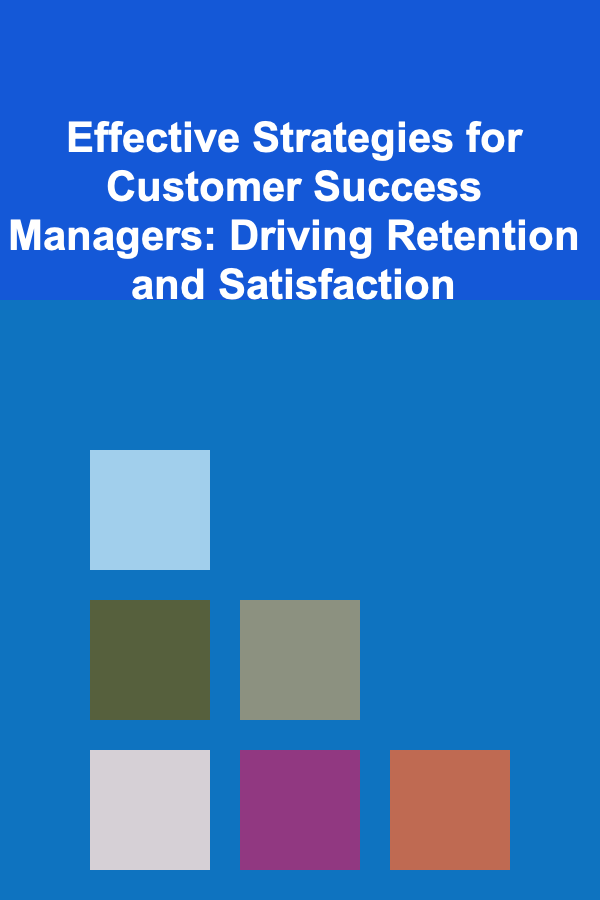
How to Create a LinkedIn Content Strategy for Your B2B Dropshipping Business
ebook include PDF & Audio bundle (Micro Guide)
$12.99$10.99
Limited Time Offer! Order within the next:

Creating an effective content strategy on LinkedIn for your B2B dropshipping business is crucial in reaching the right audience and building long-term relationships with clients and partners. LinkedIn has become an essential platform for businesses to connect, share insights, and establish thought leadership in their industries. If you're running a B2B dropshipping business, LinkedIn can help you generate leads, build credibility, and ultimately increase sales by showcasing your products and services to decision-makers.
In this guide, we will break down how to create a comprehensive LinkedIn content strategy for your B2B dropshipping business. From identifying your target audience to creating and sharing relevant content, every step is vital for optimizing your presence and driving business growth.
Define Your Objectives and Goals
The first step in creating a successful LinkedIn content strategy is to clearly define what you hope to achieve. Your goals will guide the content you create, the tone you use, and the type of engagement you want to foster with your audience.
Common B2B Goals on LinkedIn:
- Brand Awareness: Increase visibility and recognition for your dropshipping business, making sure potential clients know who you are and what you offer.
- Lead Generation: Attract decision-makers from your target industries and start conversations that could lead to partnerships and sales.
- Thought Leadership: Establish yourself as a credible and knowledgeable business in the dropshipping industry by sharing insightful content.
- Networking and Partnerships: Foster relationships with other businesses, suppliers, or industry influencers that could help grow your dropshipping operations.
By defining your goals upfront, you can tailor your content to meet these specific objectives.
Identify Your Target Audience
In B2B marketing, your target audience isn't just anyone on LinkedIn. You need to narrow down your focus and identify the key decision-makers within companies that could benefit from your dropshipping services. This could include supply chain managers, procurement officers, business owners, or marketing directors in specific industries.
Steps to Define Your Target Audience:
- Industry Focus: Decide on the industries you're targeting---fashion, electronics, home goods, etc.
- Company Size: Consider whether you want to target small businesses, mid-market companies, or large enterprises.
- Decision-Maker Roles: Identify the individuals within companies who are responsible for purchasing or supply chain decisions. These might be logistics managers, e-commerce directors, or procurement heads.
- Pain Points: Understand the common challenges your target audience faces, such as supply chain inefficiencies or difficulties in sourcing quality products.
By understanding the specific needs of your audience, you can create content that directly addresses their challenges, thus positioning your dropshipping business as the ideal solution.
Create Engaging, Value-Driven Content
Once you've defined your goals and target audience, it's time to create content that resonates with your audience and positions your business as an industry leader. LinkedIn is a professional platform, so your content should be insightful, informative, and offer value to your connections.
Types of Content to Post:
- Educational Posts: Share insights about trends in the dropshipping industry, supply chain optimization tips, or best practices for sourcing quality products. These types of posts will establish your authority and give your audience reasons to follow you.
- Case Studies and Success Stories: Show real-life examples of businesses that have benefited from your dropshipping services. These testimonials demonstrate how your solutions can solve real problems for your target audience.
- Industry News and Updates: Keep your audience informed about the latest trends in e-commerce, logistics, and dropshipping. Share articles, reports, and news that align with your business offerings.
- Behind-the-Scenes Content: Give your audience a glimpse of how your dropshipping business operates. This could be in the form of videos showing your sourcing process or infographics explaining your logistics.
- Product Highlights: Showcase your best-selling products or new arrivals. Don't just focus on features---explain how these products benefit businesses and help solve specific problems.
- Thought Leadership Articles: Write long-form content on LinkedIn that dives deeper into topics such as dropshipping best practices, building an e-commerce business, or the future of supply chain management.
- Engaging Polls and Questions: Use LinkedIn's polling feature to ask your audience questions about their pain points, preferences, or industry challenges. Polls engage users and give you insights into your target audience's needs.
Content Tips:
- Keep it Professional: Your content should reflect the tone of LinkedIn---knowledgeable, professional, and relevant to your business audience.
- Provide Solutions: Focus on providing actionable solutions, insights, or advice that directly benefits your target audience.
- Use Visuals: Incorporate images, videos, infographics, and other visual content to make your posts more engaging and easier to digest.
Post Consistently and Optimize for Engagement
Consistency is key when building a LinkedIn presence. Regular posting helps keep your dropshipping business top of mind and demonstrates your commitment to providing value. However, it's not just about posting frequently---it's also about posting at the right times to optimize engagement.
Tips for Posting Consistently:
- Post at Optimal Times: Research the best times to post on LinkedIn for your audience. For B2B, this might be during business hours, particularly in the morning or early afternoon when professionals are most likely to be browsing their LinkedIn feeds.
- Content Calendar: Develop a content calendar to organize and plan your posts. This ensures you're consistently sharing valuable content and not missing opportunities to engage with your audience.
- Engage with Comments: Don't just post content and forget about it. Respond to comments, ask follow-up questions, and actively participate in conversations to foster deeper engagement with your audience.
Leverage LinkedIn Features for B2B Engagement
LinkedIn offers a range of features that can enhance your content strategy and help you connect with your audience more effectively.
Key LinkedIn Features to Leverage:
- LinkedIn Articles: Use LinkedIn's publishing platform to write long-form content that showcases your expertise. Articles can cover in-depth topics related to dropshipping and supply chain management, and they remain on your profile for people to read long after they're posted.
- LinkedIn Groups: Join relevant LinkedIn groups where your target audience hangs out. Share valuable insights and engage in conversations to build relationships and trust.
- LinkedIn Ads: Invest in LinkedIn's sponsored content or direct messaging ads to reach key decision-makers in your target industries. LinkedIn Ads can be highly effective for B2B lead generation.
- LinkedIn Showcase Pages: If your business has multiple product lines or services, consider using Showcase Pages to create niche pages for specific offerings within your dropshipping business. These pages can focus on a particular category of products and help you target the right audience more effectively.
Analyze and Adjust Your Strategy
To ensure your LinkedIn content strategy is working, you need to regularly monitor your performance and adjust your approach as necessary. LinkedIn provides built-in analytics that allows you to track the engagement and performance of your posts.
Key Metrics to Track:
- Engagement Rate: Measure likes, comments, shares, and other interactions with your posts. This will help you gauge whether your content resonates with your audience.
- Lead Generation: Keep track of how many leads you're generating from LinkedIn, whether through direct inquiries, connections, or other actions like signing up for a newsletter.
- Follower Growth: Monitor the number of new followers you gain over time. A growing follower count indicates that your content is attracting the right audience.
Based on this data, you can refine your content strategy. For instance, if certain topics or types of posts are generating higher engagement, consider producing more content in that area. Similarly, if your posts aren't gaining traction, experiment with different formats or posting times.
Collaborate with Influencers and Partners
To extend your reach on LinkedIn, consider collaborating with influencers, industry experts, or complementary businesses in your field. B2B partnerships and influencer collaborations can help you tap into new audiences and build credibility in your niche.
Collaboration Ideas:
- Guest Posts: Invite industry experts or successful dropshipping entrepreneurs to write guest posts on your LinkedIn page.
- Webinars or Live Discussions: Host webinars or live discussions with thought leaders to share insights about the dropshipping industry.
- Co-Branding Initiatives: Work with other businesses in your network to co-create content that highlights both brands and reaches a larger audience.
Conclusion
Creating a LinkedIn content strategy for your B2B dropshipping business is a powerful way to establish your brand, attract potential clients, and grow your business. By defining clear objectives, understanding your target audience, creating valuable content, and leveraging LinkedIn's powerful features, you can build a strong presence on the platform. Remember, consistency and engagement are key to building lasting relationships and driving long-term business success on LinkedIn. By continually analyzing your performance and adjusting your strategy, you can ensure that your content stays relevant and effective in reaching your business goals.

Effective Strategies for Customer Success Managers: Driving Retention and Satisfaction
Read More
How to Build a Budget for Home Maintenance and Repairs
Read More
How to Choose Eco-Friendly Storage Options for Pet Supplies
Read More
How To Discover the Lore of Fairies and Elves
Read More
How to Organize a Family Game Night with Minimal Setup
Read More
How to Organize Your Favorite Recipes Using Technology
Read MoreOther Products

Effective Strategies for Customer Success Managers: Driving Retention and Satisfaction
Read More
How to Build a Budget for Home Maintenance and Repairs
Read More
How to Choose Eco-Friendly Storage Options for Pet Supplies
Read More
How To Discover the Lore of Fairies and Elves
Read More
How to Organize a Family Game Night with Minimal Setup
Read More